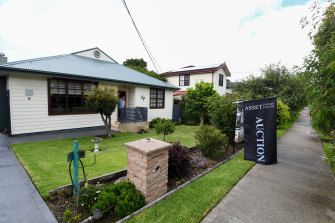- Analysis
- Money
- Borrowing
- Property prices
The premium suburbs now in reach of first home buyers
By John Collett
Sydney lifestyle hotspots, including Cronulla, Dee Why and Surry Hills, plus dozens of additional suburbs in Melbourne, will qualify for the first home buyers’ low-deposit scheme when the purchase price caps increase on July 1.
The federal government will increase the cap from $700,000 to $800,000 for Melbourne and Victorian regional centres. The cap for Sydney and NSW regional centres will increase from $800,000 to $900,000.

Higher purchase price caps for qualifying first home buyers in the federal government’s low deposit scheme puts many more suburbs in range.Credit:Photo: Peter Rae
The higher caps put apartments in some of the most desirable suburbs in Sydney into range, including St Ives and North Sydney, as they have median asking prices of more than the old cap of $800,000 but less than the new cap of $900,000, figures from My Housing Market show.
The asking or advertised prices for houses provided by My Housing Market includes townhouses.
In Melbourne, the beneficial effect of the higher cap is mostly found among houses, such as those in Boronia, Coburg North and Bundoora, as they have median asking prices of more than $700,000, but less than $800,000.
Melbourne also has many suburbs where unit prices are already under the old price cap.
The income caps for the scheme of $125,000 a year for individuals and $200,000 a year for couples is unchanged.
Andrew Wilson, chief economist at My Housing Market, says the increase in caps will help first home buyers, but is unlikely to see a return to the recent record levels of first-time buyer activity after the big property price rises of the past two years.
Those looking to buy in the premium suburbs will have to take out a bigger loan and make higher repayments, particularly if they use the low-deposit scheme, Wilson says.
“The other question is whether the increase in the caps pushes up prices in the premium first home buyer areas,” he says.
Over the past 12 months, capital city house rents increased by almost 15 per cent, while unit rents have climbed more than 11 per cent.
The contest between the Coalition and Labor has shifted to housing affordability in this federal election campaign, with both sides promising to do more to help first-time buyers enter the market.
Labor says it will support the higher low-deposit scheme caps, as it has been calling for some time in the face of the surge in prices over the past two years.
In last month’s federal budget, the government expanded the number of places available in the scheme.
First home buyers, and others, can buy new or existing dwellings with a deposit of just 5 per cent, instead of the usual 20 per cent that is needed to avoid paying expensive lenders’ mortgage insurance.
Lenders’ mortgage insurance is payable on mortgages with a loan-to-valuation ratio (LVR) of more than 80 per cent, and can cost a borrower several thousands of dollars.
The budget also included more assistance for regional property buyers, including non-first home buyers, to be introduced from October 1.
Labor, if elected at the federal election on May 21, has promised to create a program to help 10,000 first-home buyers a year in regional Australia to buy a home.
It has also pledged to create a $10 billion Housing Australia Future Fund that would build 30,000 new social and affordable housing properties in its first five years.
The Coalition has promised to provide an additional $2 billion in low-cost financing to Community Housing Providers, to build new social and affordable rental dwellings.
Property prices in Sydney and Melbourne are falling slightly and, if the trend continues, even more suburbs will have prices that fall under the price caps for the low-deposit scheme.
However, first home buyers may still find it even harder to get a foot on the property ladder, with variable mortgage interest rates widely tipped to start rising this year, perhaps as early as June. The rapidly rising cost of living is already reducing their capacity to save and to borrow.
Some analysts are expecting the slight falls in property prices in Sydney and Melbourne that have occurred so far this year to pick up as rates rise.
Wilson says low-deposit schemes help, as often the biggest hurdle to buying a home is saving for the deposit.
However, rising rents and the increasing cost of living are making it more difficult for first home buyers to save, Wilson says.
Over the past 12 months, capital city house rents increased by almost 15 per cent, while unit rents have climbed more than 11 per cent.
The national residential property rental vacancy rate fell to just 1 per cent in March – the lowest rate since 2006 – figures from SQM Research show.